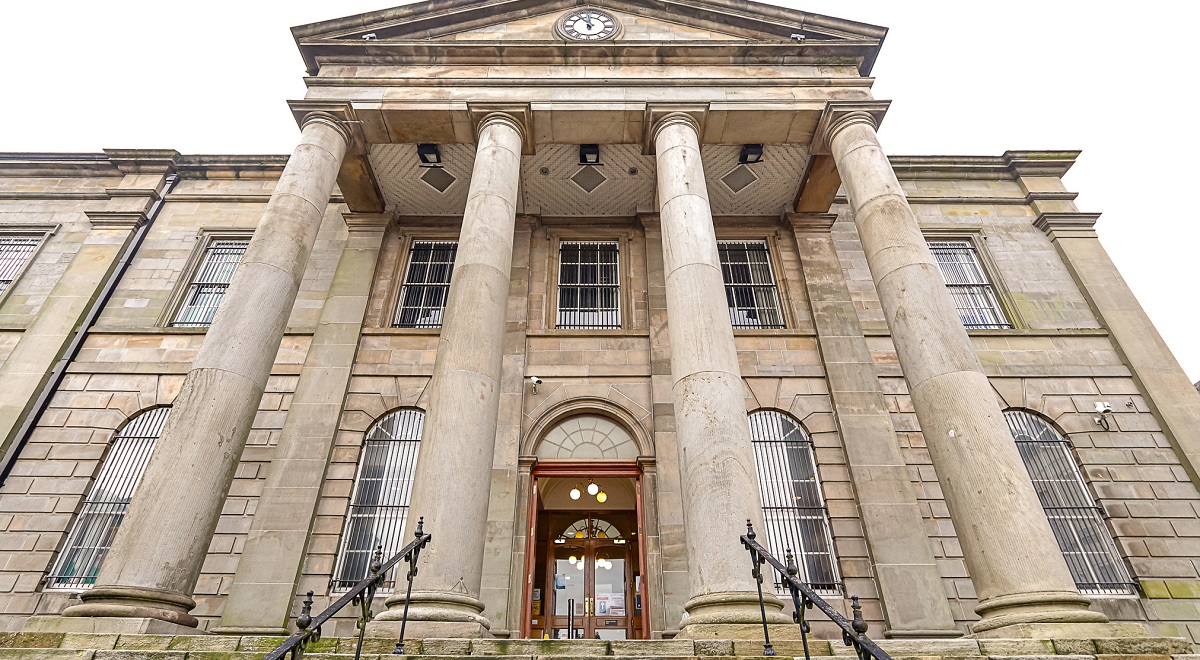People dread walking the 12 steps leading up to Omagh Courthouse… as through those decisive doors, some may never see the back of them.
Thankfully, I was able to emerge a free man after the staff gave me an exclusive tour of a landmark building in Omagh’s history.
This began in the administrative building, where I came through the entrance and was met with an airport-style metal detector and a security staff member, armed with a detector wand, prepared for any attempted smuggling of illicit items into the courts.
So I lugged my camera, pens, wallet and keys into the tray and proceeded to walk through… only to be met by the sound of an alarm.
Of course, I forgot to factor in that my glasses were metal!
I eventually got through the doors, and waited for my host upstairs. In this moment, I embraced my surroundings, and observed the contrasting architecture of an 1970s-style office imposed on the 200-year-old building.
One thing that struck me was how the architecture and furniture was similar to what you would see in many of the churches in Omagh.
A particular feature is the woodwork, which was of a consistent, glossy, light-coloured wood, making up the skirting boards, pews, frames, backboards.
It was the same wood everywhere.
Omagh Courthouse was designed to fit four courts, all serving different purposes. When you engage your imagination and look past the modern TVs, microphones and computer, you are literally peering into a time capsule.
I envisaged judges and barristers in their gowns and wigs reading out the verbose technicalities of law under the dark haze of a grey rainy morning, as the custodial officer with his large metal keys stands beside the accused in the caged wooden stand.
The size of the rooms differ greatly, depending on what side of criminality you stood. All public and staff areas were of grand scale; large, open, well-lit with vibrant colours of cream, green and brown.
In contrast to the grandiose surroundings witnessed throughout the main building, the custodial cells are small, cramped, monotone and featureless.
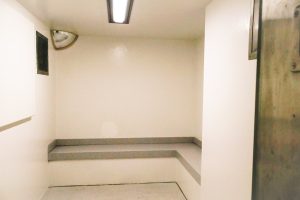
This blandness creates a feeling of a grim limbo, which is, perhaps, a metaphor for the situation potential convicts find themselves in as they await their judgment.
However, it is in this section that the most interesting parts of the building’s history are located.
In times gone by, there were a series of tunnels under Omagh which connected certain buildings in the town. One such connection was to these holding cells.
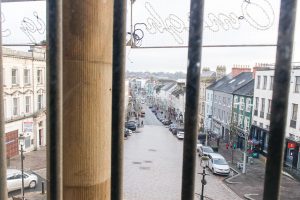
Omagh Police Station was once located on the site of the former ‘Ranch’ restaurant, just across the road from the Courthouse.
For convenience, and the safety of those on trial, prisoners were transported via an underground tunnel straight to the courthouse before their trial.
Indeed, throughout the years, the Omagh Courthouse has dealt with its fair share of crimes, prisoners and inquests.
One of the most famous cases resulted in the only death sentence of a Royal Irish Constabulary (RIC) officer, Thomas Hartley Montgomery.
The sub-inspector had stabbed Newtownstewart Northern Bank clerk, William Glass, and stolen £1,600.
Sub-inspector Montgomery then attempted to thwart any suspicion of his murder, but failed as lower-ranking officers uncovered his financial difficulties, and a witness saw the officer leaving the bank around the time of the murder.
In 1873, the disgraced policeman was convicted of murder, and hanged in the Omagh Gaol.
The courthouse stands at the highest point over the town, a dominant presence, almost acting as the wise grandfather, reminding townsfolk and outsiders alike of the boundaries of societal order.
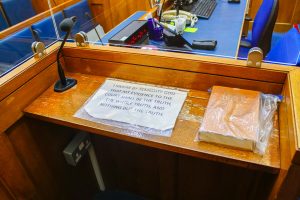
The historic house was built around 1814 (at a cost of approximately £17,000) on the site of the old Gaol by architect John Hargreaves of Cork in the ‘Greek Revival’ style, which was vastly popular for its time.
This style is most prevalent at the face of the courthouse, with the four Doric pillars.
On top of these pillars rests the pediment, a triangular structure.
Within the pediment resides a clock, and surmounting the pediment, is the Royal Coat of Arms, with the two heraldic beasts of the lion and unicorn resting either side, with their heads proudly raised.
Though it is not known fully what the symbolism of the English lion and Scottish unicorn represents, it is speculated that they were rivals which came together under the crown of the United Kingdom as ‘bravery’ and ‘courage’.
Our eyes are frequently drawn to the large clock, which, for many years, reminded people of the time of day. Except from 2013-19 when it stopped!
However, thankfully the clock has been ticking along nicely since.
Like many courthouses in the North, the Omagh building was a target during the Troubles.
It was damaged in a devastating bomb blast in October 1983, when a device was left on the courthouse steps.
The explosion was of such force that buildings within a 500-yard radius in John Street, George’s Street and High Street were also severely damaged, while two civilians were slightly injured.
Today, some of the Troubles-era caged security structures can still be spotted along the side of the courthouse.
Given its prominent location, the front of the courthouse building has been the scene of many high profile protests and gatherings.
Most notable was a memorial service one week after the Omagh Bomb, and a hospital campaign protest in the early 2000s.
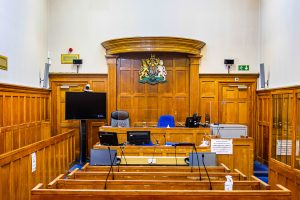
In February of this year, hundreds of people gathered in front of the courthouse steps for a collective message of ‘No Going Back’ after the shooting of DCI John Caldwell at Youth Sport Omagh.
Another protest that lives long in the memory involved hundreds of people and schoolchildren who gathered at the courthouse steps the day after Bloody Sunday in January, 1972.
What the future holds for Omagh Courthouse remains to be seen, however.
The historic structure has seen a significant reduction in cases heard there, with the majority of more serious cases and inquests now taking place in Dungannon.
But, if only walls could talk… as one of our oldest buildings would certainly have many interesting stories to tell!
Did you know?
- On the second floor is the only bulletproof glass in the whole courthouse. If you look close enough, you can see the slight blue tinge of where would be the County Court. The reason behind this is because it is the only clear line-of-sight to the judge.
- l One little known fact is that this was not the original courthouse of Omagh, and another had stood for nearly 75 years prior to the current building. The original courthouse burned down in 1742 due to an accidental fire which destroyed most of Omagh’s landmarks.
- l In and around the peak of the famines, it is reported that the Guardians of Omagh’s Workhouse held their weekly meetings in the courthouse to avoid the rampant disease spreading across the workhouse.
- l One may notice that the left side of the courthouse is a different colour to the rest of the building, and that is because different stone was used to construct the administrative block as an addition to the original building years after its construction.
- l Before the ‘Troubles’, when there was no need for security to be as tight, the courthouse was easily accessible to the public, and, at one stage, it even hosted dances, according to a story in the Donegal News on October 19, 1935.
- l Following the implementation of the Local Government (Ireland) act of 1898, the growing council decided to inhabit and conduct council business in the courthouse alongside the delivery of justice. However, as the council grew, there was little space and the courthouse became too cramped, so the council left for a larger space of its own, and moved to the County Hall in 1962.
- l In 1902, a statue dedicated to the South African Boer War was opened on High Street in front of the courthouse. However, the influx of motorists in the ‘60s meant it was deemed a traffic hazard, so it was moved to Drumragh Avenue in 1964.






